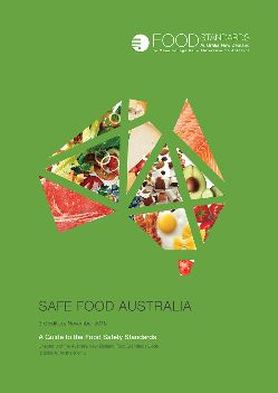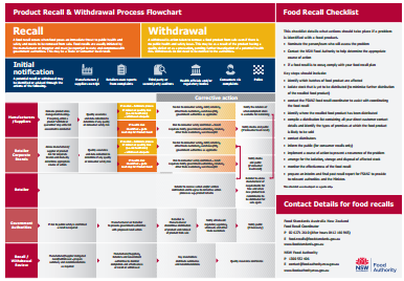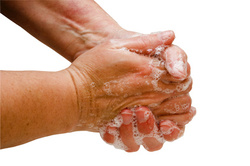Here is a copy of Codex HACCP (2023 version)
2023 Version
For use in all HACCP training and Auditing food safety training.
Download this file for use in training or workplace.
| codex_haccp_2023.pdf |
| ✓ Correct Training Systems |
|
Here is a copy of Codex HACCP (2023 version)General Principles of Food Hygiene. Codex Alimentarius Code of Practice, No.CXC 1-1969. 2023 Version For use in all HACCP training and Auditing food safety training. Download this file for use in training or workplace.
CTS students are able to access a sample HACCP 2020 Manual, to support their learnings. This sample is fictitious and has been abridged. It is not fully complete with small sections of information deleted. It does provide a sample of a HACCP 2020 structure and typical procedures in a HACCP FSP. It contains a sample of a RECALL procedure suitable for a HACCP certified business.
All GFSI and HACCP programs now require the business to build a positive food safety culture at work by developing awareness, empowerment and commitment to food safety.
There is a 2 minute free online U Tube video introducing the topic of "What is Food Safety Culture", produced by Safe Food Production QLD. It may be a useful introduction to staff to start discussion about the importance of building a positive Food Safety Culture. Codex Alimentarius The General Principles of Food Hygiene CXC 1- 1969 has been updated in late 2020. Changes include:
Correct Food Systems will be working with our clients to make any required adjustment to HACCP plans. We will be allowing adequate time for businesses make the necessary changes to their HACCP plans. Download Codex HACCP 2020 below. Register now for a Update - HACCP Refresher 2020 trainng
Click here to download a simple audit report to use in your workplace.
FSANZ Food Standards Code 3.2.2.
Food Standards Practices and general requirements  This 3rd Edition, November 2016 updated reference provides guidance to the three food safety standards in Chapter 3 of the Australia New Zealand Food Standards Code (the Code). Businesses can use the guidance information to help them to comply with the standards. It also provides new guidance for mobile, temporary and home-based vendors, as well as generic food safety record templates. Down load the new version of Safe Food Australia The FSANZ website also launched a "Food Safety Hub", as a page that provides links to
Compendium updated in 2022 The Compendium of Microbiological Criteria for Food is a food industry resource, published by FSANZ. It is a microbiological guideline criteria used for ready-to-eat foods. It also provides microbiological criteria that can be used to verify hygiene measures or control of processing. It supersedes the Guidelines for the microbiological examination of ready-to-eat foods and User guide to Standard 1.6.1 - Microbiological Limits for Food with additional guidelines criteria. This compendium brings together information on:
This is a guideline document to Standard 3.2.2 Food Safety Practices and General Requirements. This Standard sets out specific requirements for food businesses and food handlers that, if complied with, will ensure food does not become unsafe or unsuitable. This Standard specifies process control requirements to be satisfied at each step of the food handling process. Some requirements relate to the receipt, storage, processing, display, packaging, distribution disposal and recall of food. Other requirements relate to the skills and knowledge of food handlers and their supervisors, the health and hygiene of food handlers, and the cleaning, sanitising, and maintenance of premises and equipment. Download this Guideline here. This document is recommended reading for all of the CTS training programs.
This guideline prepared by the NSW Food Authority explains the mandatory requirements detailed in current legislation and the Food Standards Code 3.3.1. It covers Licencing requirements that apply; Specific issues for a food safety program for a 3.3.1 licenced facility; Menu design; Preparation and Storage of ready to eat foods( not cooked); Cook Serve foods; Cook Chill foods; Preparation of texture modified and pureed foods; preparation of infant formula; Allergen control. It acts reference material for Cook Chill food preparation, HACCP and food safety programs, and auditing facilities that prepare and serve food to vulnerable populations. This document is recommended reading for the CTS Audit a Cook Chill Process training program.
The Allergen Bureau has published a PDF of a presentation on Allergen Fundamentals.
This resource can be downloaded from the Allergen Bureau here. This free resource is provided by the Allergen Bureau for:
HACCP is a system which identifies, evaluates, and controls hazards which are significant for food safety. First adopted in 1969. Amendment 1999. Revisions 1997 and 2003.
This document sets out the principles and Guidelines of the Hazard Analysis and Critical Control Point (HACCP) system adopted by the Codex Alimentarius Commission. The Principles of the HACCP System set the basis for the requirements for the application of HACCP, while the Guidelines for the Application provide general guidance for practical application. 12 steps of HACCP and the CCP decision tree is in the annex of this document. Download the 2003 Codex HACCP CAC/RCP 1-1969, Rev. 4-2003 - Annex here_. Here are some documents that are widely used in the HACCP plan or HACCP study when developing a HACCP Food Safety Plan.
1. WRAC table for HACCP hazard analysis 2. CCP decision tree Download these resources here. Businesses that manufacture or wholesale food in NSW fall under the NSW Food Authority’s Manufacturer/Wholesaler Food Inspection Program and are required to have inspections. These inspections will be unannounced visits. This NSW Food Authority fact sheet outlines what wil be expected and inspected at a food processing, importing or wholesaling business.
( click here )
 Under the Food Standards Code, a food handler must take all reasonable measures not to handle food or food surfaces in a way that is likely to compromise the safety and suitability of food and protect food from contamination. Food handlers also have specific responsibilities relating to health and hygiene. This NSW Food Authority fact sheet outline the Health and Hygiene responsibilities. (click here) The NSW Food Authority has “General Guidelines for the Development and Implementation of a Food Safety Program”, “Food Safety Program Template” as guidance documents. un licenced businesses. This template is based on the principles of HACCP, but does not meet all requirements for a certified HACCP food safety program. It is not suitable for NSW Food Authority licenced business.
If using these document to develop your Food Safety Program then you must adapt these to fit your business, products,compliance and and market requirements, and to ensure that all potential food safety hazards are correctly identified and appropriately controlled.You are advised to seek independent professional advice in relation to any query you may have regarding the legal obligations and regulatory compliance requirements.
 NSW Food Authority has a useful flowchart to use to determine withdrawal or recall action. (Click here) The NSW Food Authority (the Food Authority) has prepared the NSW Food Safety Schemes Manual (the Manual) to specify certain requirements for the following Food Safety Schemes under the Food Regulation 2015: This outline the tests and frequency for NSW business that fall under
Dairy food safety scheme, Meat food safety scheme, Plant products food safety scheme, Seafood safety scheme , Vulnerable persons food safety scheme , Egg food safety scheme. (Click here)  Handwashing is the most critical action to avoid cross contamination within a food business. Proper hand washing at the right times helps to prevent microorganisms spreading to food. Print this NSW Food Authority guide off to give to you staff, at induction or as part of regular food safety and hygiene training. ( click here ) Businesses are required to maintain a calibration program, in order to ensure thermometers do not
exceed a +/- 1°C tolerance. Calibration of thermometers can be affected and possibly produce inaccurate results when the boiling point of water of 100°C is used in an area of high altitude. Those calibrating thermometers and undertaking internal and external audits should note the reduced boiling point of water at higher altitude. The NSW Food Authority has published a table of the various boiling points of water in°C at varying altitudes. This information and table can be found here. The Food Regulation 2015 requires that certain industry sectors are licensed with the NSW Food Authority.
The Food Authority, or approved NSW Food Authority regulatory auditor undertakes regular audits and inspections of all licensed businesses. Further information about the requirements for audits of licenced food businesses in NSW can be found at the NSW Food Authority website, or click here |
Categories/
|
||||||||||||||||||||||||||||||||||||||||||||||||||||||||
Correct Food Systems-
|
|